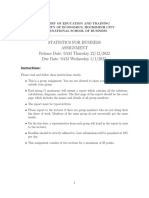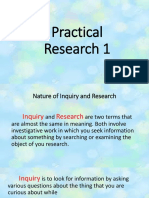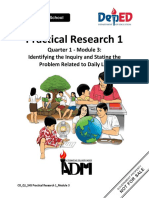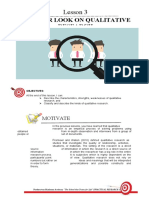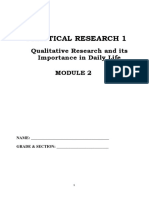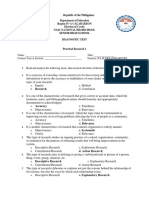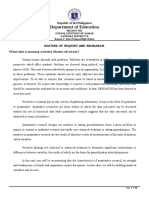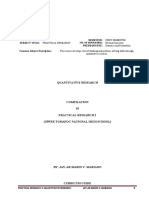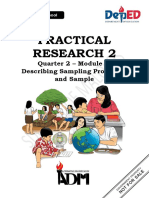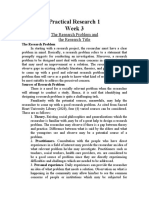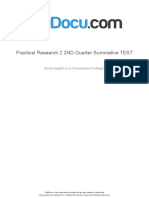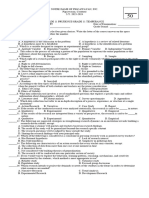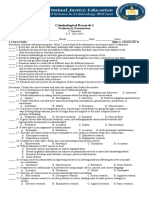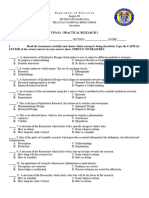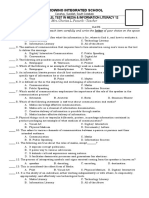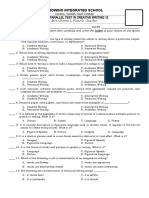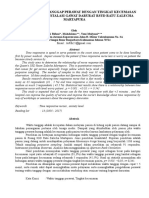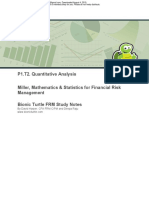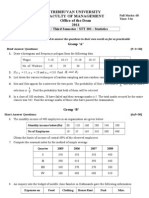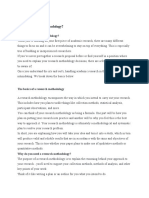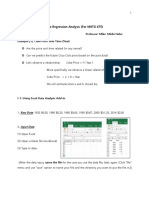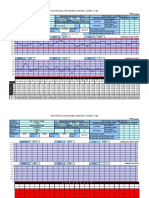100%(2)100% found this document useful (2 votes)
2K viewsFirst Parallel Test in Practical Research 1: Godwino Integrated School
First Parallel Test in Practical Research 1: Godwino Integrated School
Uploaded by
Chariza L. PacuribThis document appears to be a test on research methods for a class called Practical Research 1. It contains 29 multiple choice questions testing knowledge of key concepts in research methods, including the differences between qualitative and quantitative research, purposes and characteristics of research, ethics in research, and components of the research process like developing research problems, questions, hypotheses and designs. The test questions cover terminology, procedures, and appropriate applications of qualitative and quantitative methodologies.
Copyright:
© All Rights Reserved
Available Formats
Download as DOCX, PDF, TXT or read online from Scribd
First Parallel Test in Practical Research 1: Godwino Integrated School
First Parallel Test in Practical Research 1: Godwino Integrated School
Uploaded by
Chariza L. Pacurib100%(2)100% found this document useful (2 votes)
2K views4 pagesThis document appears to be a test on research methods for a class called Practical Research 1. It contains 29 multiple choice questions testing knowledge of key concepts in research methods, including the differences between qualitative and quantitative research, purposes and characteristics of research, ethics in research, and components of the research process like developing research problems, questions, hypotheses and designs. The test questions cover terminology, procedures, and appropriate applications of qualitative and quantitative methodologies.
Original Title
5. Research 1 - 12
Copyright
© © All Rights Reserved
Available Formats
DOCX, PDF, TXT or read online from Scribd
Share this document
Did you find this document useful?
Is this content inappropriate?
This document appears to be a test on research methods for a class called Practical Research 1. It contains 29 multiple choice questions testing knowledge of key concepts in research methods, including the differences between qualitative and quantitative research, purposes and characteristics of research, ethics in research, and components of the research process like developing research problems, questions, hypotheses and designs. The test questions cover terminology, procedures, and appropriate applications of qualitative and quantitative methodologies.
Copyright:
© All Rights Reserved
Available Formats
Download as DOCX, PDF, TXT or read online from Scribd
Download as docx, pdf, or txt
100%(2)100% found this document useful (2 votes)
2K views4 pagesFirst Parallel Test in Practical Research 1: Godwino Integrated School
First Parallel Test in Practical Research 1: Godwino Integrated School
Uploaded by
Chariza L. PacuribThis document appears to be a test on research methods for a class called Practical Research 1. It contains 29 multiple choice questions testing knowledge of key concepts in research methods, including the differences between qualitative and quantitative research, purposes and characteristics of research, ethics in research, and components of the research process like developing research problems, questions, hypotheses and designs. The test questions cover terminology, procedures, and appropriate applications of qualitative and quantitative methodologies.
Copyright:
© All Rights Reserved
Available Formats
Download as DOCX, PDF, TXT or read online from Scribd
Download as docx, pdf, or txt
You are on page 1of 4
At a glance
Powered by AI
Some of the key takeaways from the document are that qualitative research aims to understand phenomena in their natural settings, collects data in various manners to get rich descriptions, and values are an integral part of the research process. Quantitative research presents data in numbers and relies on quantity of literature.
Qualitative research is descriptive while quantitative research is experimental. Qualitative research presents data in words while quantitative research presents data in numbers. Qualitative research ensures in-depth understanding while quantitative research counts on quantity of literature.
Some characteristics of good research include being systematic, following valid procedures, being objective and unbiased, being empirical by relying on observations and experiences, and aiming to find answers to questions.
GODWINO INTEGRATED SCHOOL
Canahay, Surallah, South Cotabato
FIRST PARALLEL TEST IN PRACTICAL RESEARCH 1
Mrs. Chariza L. Pacurib - Teacher
NAME: ________________________________________________ DATE: _________________________
I. MULTIPLE CHOICE: Read each item carefully and write the letter of your choice on the space
provided before the number.
_____ 1. It is a systematic inquiry that describes, explain, predict and control the observed phenomenon.
A. Research B. Analysis C. Thesis D. Case Study
_____ 2. It is a process of naturalistic inquiry that seeks in-depth understanding of social phenomena
within their natural setting.
A. Qualitative Research C. Variables
B. Quantitative Research D. Hypothesis
_____ 3. It is a structured way of collecting and analyzing data obtained from different sources.
A. Hypothesis C. Variables
B. Quantitative Research D. Qualitative Research
_____ 4. It is a process that answers what is the problem and why should it be studied.
A. Formulating Hypothesis C. Identifying Problems
B. Review of Related Literature D. Analyzing the Data
_____ 5. It is a process that answers how the finding in relations to the hypothesis is.
A. Drawing conclusion C. Interpreting Data
B. Data Analysis D. Formulating Hypothesis
_____ 6. How does qualitative research differ from quantitative research?
A. Qualitative research is descriptive while quantitative research is pure experimental.
B. Qualitative research is done by beginners while quantitative research is done by the
experts.
C. Qualitative research presents data in words while quantitative research presents data in
numbers.
D. Qualitative research ensures quality of related literature while quantitative research
counts on quantity of related literature.
_____ 7. The following statements are the importance of research EXCEPT _______________.
A. Research can lead to expansion of knowledge and new discoveries.
B. It helps us find ways to allocate scarce resources accordingly.
C. It may not help in studying the effects of observed phenomena.
D. It develops critical thinking and analysis.
_____ 8. It is a process that answers what information is already available.
A. Review of Related Literature C. Interpreting Data
B. Sampling D. Data Analysis
_____ 9. It is a process that answers how to identify or select your respondents.
A. Sampling C. Review of Related Literature
B. Data Analysis D. Interpreting Data
_____ 10. Which of the following is TRUE about qualitative researchers?
A. Numerical data are necessary in presenting, analyzing and interpreting data.
B. Values are integral part of the research process.
C. Facts stand independent of the knower and can be known in a distorted way.
D. The proper design of research investigations will lead to accurate conclusions about the
nature of the world.
_____ 11. Why should researchers use qualitative research methods?
A. It is because natural science models shouldn’t be applied as studies of social life.
B. It is because they want to get richer data on their subject in order to understand the
HOWs and WHYs.
C. It is because some researchers see qualitative research as a way to have an in-depth
understanding about a certain topic being studied.
D. all of the above
______ 12. It is a characteristic of a research that is based on direct experience or observation by the
researcher.
A. Objective C. Empirical
B. Systematic D. Controlled
______ 13. It is a characteristic of a research that follows orderly and sequential procedures, based on valid
procedure and principle.
A. Systematic C. Original Work
B. Objective D. Analytical
_______ 14. It is a characteristic of a research which refers to the unbiased and logical.
A. Objective C. Analytical
B. Original Work D. Empirical
_______ 15. It is a characteristic of a research that refers to search facts, answers to questions and
solution to problem.
A. Systematic C. Objective
B. Employs Hypothesis D. Empirical
_______ 16. Which of the following is NOT a purpose of research?
A. To construct or create new procedures or systems
B. To serve as a basis for decision-making
C. To deprive someone of the knowledge he/she needs to know
D. To prove or disprove a theory
_______ 17. Which of the following is the advantage of qualitative research?
A. It is instrumental for positive and societal changes.
B. It involves a lot of researcher’s subjectivity in data analysis.
C. It is hard to know the validity or reliability of the data
D. It is open-ended questions yield “data overload” that requires long-time analysis
_______ 18. It is an ethics of a research which to keep promises and agreements.
A. Honesty C. Integrity
B. Objectivity D. Openness
_______ 19. It is an ethics of a research that gives proper acknowledgment or credit for all researchers.
A. Intellectual Property C. Social Responsible
B. Responsible Mentoring D. Confidentiality
_______ 20. This type of research that is purely direct application, but expanding the nature of
understanding about the problem.
A. Applied Research C. Thesis
B. Case Study D. Basic Research
_______ 21. It is a type of research that needs answer to a specific question. It teaches and provides
validation in order to apply to the real setting.
A. Applied Research C. Thesis
B. Case Study D. Basic Research
_______ 22. A researcher studies one gifted student in order to better understand how this student’s school
day differs from that of more typical students. This is a qualitative study because of the
following reasons EXCEPT _____________.
A. It aims to analyse cases and situations using numerical data.
B. It aims to investigate existing situations or problems.
C. It aims to provide solutions to problems.
D. It aims to explore or analyze more certain issues.
_______ 23. Which among the following best describes Statement of the Problem?
A. It discusses the scope of the study and its limitation.
B. It is a concise description of an issue to be addressed or a condition to be improved.
C. It introduces the study by connecting the gaps among existing studies in a real world
scenario.
D. It gives a brief description of the benefits that the benefactors can get from the study.
_______ 24. Which of the following is the least purpose of research?
A. Improve reading and writing skills
B. Learn how to work independently
C. Gain in-depth knowledge (scientifically or systematically)
D. Find ways on how to improve societal problems
_______ 25. The following are characteristics of qualitative research, EXCEPT
A. It focuses on participants’ perceptions
B. Its method used is interactive
C. It takes place in a natural setting
D. It analyzes data using statistical tools
_______ 26. Which of the following gives the aim and goal of the research?
A. Statement of the Problem C. Review of Related Literature
B. Research Design D. Sampling Technique
_______ 27. Which of the following is NOT a general feature that characterizes qualitative research?
A. Inflexible Design C. Holistic Perspective
B. Naturalistic Inquiry D. Personal Contact and Insight
_______ 28. Research results requires exhaustive analyzing of the meaning of the data. This shows
the_______________.
A. Weakness of qualitative research
B. Areas for improvement of qualitative research
C. Strength of qualitative research
D. Direction of qualitative research
_______ 29. It is believed to be one of the weaknesses of qualitative research.
A. It can develop theories.
B. It has several avenues to understand phenomena.
C. The way a researcher perceives things is immersed in the study.
D. It answers certain phenomena- social, economic, political and psychological.
_______ 30. One of the following is a weakness of qualitative research.
A. Data are based on human experience.
B. It includes detailed examination of issues.
C. It can be quickly revised as new information emerges.
D. It has to deal with issue on confidentiality and anonymity of the subject.
_______ 31. When collecting data about students’ attitude toward math, one way of doing it is through
observation in the actual class. It is because, in qualitative research, data should be collected
in a ______________
A. difficult situation C. gathering of people
B. natural setting D. closed area
_______ 32. In qualitative research, data are collected in different manners. The reason behind this
technique is ____________
A. to gather comprehensive and rich description of the subject
B. to give options to the researcher which data are the best
C. to keep the researcher busy for the entire period of the study
D. give justice to the chosen participants of the study by exposing them in different
situations
_______ 33. One of the following is NOT a good contributor of ideas in research.
A. People who aspire to do research study
B. People who are knowledgeable about the topic
C. People who have opposing views about the research
D. People whose opinions may differ from the researcher
_______ 34. Researchers should avoid controversial topic because _______________.
A. It lacks focus along the process.
B. It is prone to opinions of the subject.
C. It requires thorough and extensive reading.
D. There are no available materials as source of information to support it.
_______ 35. The following are the reasons why qualitative study should be conducted EXCEPT___________?
A. because it deepens the understanding of a certain phenomenon.
B. because it discusses someone’s culture that includes traditions, beliefs,
A. language, etc.
B. because it gives emphasis on the stories that the participants experienced.
C. because it allows the researcher to analyze data using numerical inputs.
_______ 36. As a remedy, a broad research topic should be ___________.
A. Narrowed down
B. Converted into a broader topic
C. Supported with extensive reading and investigation
D. Challenging to the researcher as it needs more sources
_______ 37. This is a statement containing the main point, main idea or central message of the paper.
A. Conceptual framework C. Thesis statement
B. Significance of the study D. Statement of the problem
_______ 38. This is the chapter where the significance of the study is particularly indicated.
A. Chapter 1 B. Chapter 2 C. Chapter 3 D. Chapter 4
_______ 39. What is the true meaning of the word accuracy in research?
A. It must take place in an organized or orderly manner.
B. It must deal with opinions arising from assumptions.
C. Its topic must be instrumental in improving society or in solving problems.
D. It must give correct data: footnotes, notes, and bibliographical entry should be honestly
and appropriately documented.
_______ 40. One of the following research topics below needs to be narrowed down into specific one.
A. Menace of Terrorism in Mindanao
B. HIV: Causes, Prevention and Cure
C. Global Warming and Greenhouse Effect
D. Body Tattooing as an Art in the Philippines
ANSWER KEY:
1. A
2. A
3. B
4. C
5. A
6. C
7. C
8. A
9. A
10. D
11. D
12. C
13. A
14. A
15. B
16. C
17. A
18. C
19. A
20. D
21. A
22. A
23. B
24. B
25. D
26. A
27. A
28. A
29. C
30. D
31. B
32. A
33. C
34. D
35. C
36. A
37. B
38. B
39. D
40. C
You might also like
- SB AssignmentDocument3 pagesSB AssignmentLê Hoàng Minh AnhNo ratings yet
- Choosing Appropriate Quantitative Research DesignDocument8 pagesChoosing Appropriate Quantitative Research DesignNica Guen PhalaNo ratings yet
- BA Module 02 - 2.1 + 2.2Document12 pagesBA Module 02 - 2.1 + 2.2ScarfaceXXXNo ratings yet
- Practical Research 1 Quarter 1 - Module 8: Designing A Research Project Related To Daily LifeDocument17 pagesPractical Research 1 Quarter 1 - Module 8: Designing A Research Project Related To Daily LifeMark Allen Labasan100% (1)
- PR-2 Q1 W1-W7 PDFDocument68 pagesPR-2 Q1 W1-W7 PDFRaylyn Heart RoyNo ratings yet
- Applied - 11 - Research in Daily Life 1 - semII - CLAS4A - The Range of Research Topics in The Area of Inquiry - v6 PNSDocument19 pagesApplied - 11 - Research in Daily Life 1 - semII - CLAS4A - The Range of Research Topics in The Area of Inquiry - v6 PNSVienie Ramirez Badang100% (1)
- Pointers To Review For Practical ResearchDocument4 pagesPointers To Review For Practical ResearchMary Grace Sagun0% (1)
- Physics Investigatory: Young'S Double Split Experiment AND Effect of Diffraction in InterferenceDocument9 pagesPhysics Investigatory: Young'S Double Split Experiment AND Effect of Diffraction in InterferenceVarun Chaudhary10% (10)
- Forecasting Assignment 1Document3 pagesForecasting Assignment 1Sumit Kumar0% (1)
- Metrology and Measurements - Lecture Notes, Study Material and Important Questions, AnswersDocument7 pagesMetrology and Measurements - Lecture Notes, Study Material and Important Questions, AnswersM.V. TVNo ratings yet
- Practical Research 1 Midterm Exam 2020Document2 pagesPractical Research 1 Midterm Exam 2020Michelle Berme44% (9)
- Background of Research: LessonDocument8 pagesBackground of Research: LessonSher-Anne Fernandez - BelmoroNo ratings yet
- Practical Research 1Document19 pagesPractical Research 1Ferlyn CastellejoNo ratings yet
- Applied Practical Research 1 - q1 - Mod3 v2Document31 pagesApplied Practical Research 1 - q1 - Mod3 v2Grace06 Labin100% (2)
- Practical Research 2 Module PDFDocument131 pagesPractical Research 2 Module PDFJeffrey Masicap100% (3)
- Pr2 Quarter Exam ReviewerDocument150 pagesPr2 Quarter Exam ReviewerItsClarenceNo ratings yet
- Research 2 2nd QuarterDocument45 pagesResearch 2 2nd QuarterCaroline de Taza100% (1)
- Practical Research 1: Quarter 3 - Module 1Document19 pagesPractical Research 1: Quarter 3 - Module 1XYRA LOU SEDANo ratings yet
- Practical Research 1 LAS Weeks 3 and 4Document16 pagesPractical Research 1 LAS Weeks 3 and 4Aruel Delim100% (1)
- PR1 Q4 Week1 Las 1 2Document6 pagesPR1 Q4 Week1 Las 1 2JulieAnnLucasBagamaspadNo ratings yet
- Practical Research 1 Quarter 1-Module11: "Ask Me How"Document11 pagesPractical Research 1 Quarter 1-Module11: "Ask Me How"Mark Allen LabasanNo ratings yet
- G11 Practical Research Lesson 3Document7 pagesG11 Practical Research Lesson 3Jay Mark Cartera TumalaNo ratings yet
- Summative Test in Practical Research 1Document1 pageSummative Test in Practical Research 1Michelle Iris100% (1)
- Practical Research 1 Module 4 - REVISEDDocument25 pagesPractical Research 1 Module 4 - REVISEDRowena SoronioNo ratings yet
- PR2 LESSON 3 Kinds of Quantitative ResearchDocument3 pagesPR2 LESSON 3 Kinds of Quantitative ResearchMiles MendozaNo ratings yet
- Department of Education: Learning Activity Worksheets (LAW) Practical Research 2 Grade 12Document8 pagesDepartment of Education: Learning Activity Worksheets (LAW) Practical Research 2 Grade 12Kayzelle RefamonteNo ratings yet
- APPLIED PRACTICAL RESEARCH 1 - Q1 - Mod2 V2Document22 pagesAPPLIED PRACTICAL RESEARCH 1 - Q1 - Mod2 V2Sheryl Osorio100% (1)
- Quiz 2 WEEK 3 - TejidoDocument4 pagesQuiz 2 WEEK 3 - TejidoRhania TejidoNo ratings yet
- Research Across Fields: Cs - Rs11-Iiia-5 Provide Examples of Research inDocument4 pagesResearch Across Fields: Cs - Rs11-Iiia-5 Provide Examples of Research inNazarene Madapin100% (1)
- PR2 Module 1st QuarterDocument66 pagesPR2 Module 1st Quarterthailajoy ringorNo ratings yet
- Practical Research 1-Week5-6Document22 pagesPractical Research 1-Week5-6XYRA LOU SEDANo ratings yet
- First Summative Exam PR2Document4 pagesFirst Summative Exam PR2ShineElefanteEstudillo67% (3)
- Practical Research 1: Quarter 1-Module 4: Learning From Others and Reviewing The LiteratureDocument14 pagesPractical Research 1: Quarter 1-Module 4: Learning From Others and Reviewing The LiteratureAlehxis Gglc Fonts RnlptNo ratings yet
- Practical Research 1 11 q2 m1Document14 pagesPractical Research 1 11 q2 m1Kaye Flores100% (2)
- Rs101 - Module 2 (PDF File)Document26 pagesRs101 - Module 2 (PDF File)Jay DhelNo ratings yet
- Nature and Inquiry of Research: GradeDocument46 pagesNature and Inquiry of Research: GradeJodemarie Rivera RullanNo ratings yet
- Research DiagnosticDocument4 pagesResearch DiagnosticJulieSanchezErsandoNo ratings yet
- Practical Research 1 Q1 M6Document4 pagesPractical Research 1 Q1 M6dv vargas100% (2)
- Practical Research 1 - Quarter 1 - Module 3 - Identifying The Inquiry - Version 3Document44 pagesPractical Research 1 - Quarter 1 - Module 3 - Identifying The Inquiry - Version 3Eustass Kidd75% (4)
- 3rd Exam Pr1 2019 (Answer Key)Document5 pages3rd Exam Pr1 2019 (Answer Key)Merlanie MaganaNo ratings yet
- LAS Practical Research 1 12Document4 pagesLAS Practical Research 1 12OliverNo ratings yet
- UNIT 3 - LESSON 1 - Identifying Qualitative Research ProblemDocument56 pagesUNIT 3 - LESSON 1 - Identifying Qualitative Research ProblemmikkaellaNo ratings yet
- Week 1 PR 2Document30 pagesWeek 1 PR 2Ar Anne UgotNo ratings yet
- Practical Research 1 - Quarter 1 - Module 1 - Nature and Inquiry of Research - Version 3Document53 pagesPractical Research 1 - Quarter 1 - Module 1 - Nature and Inquiry of Research - Version 3Caranay Billy100% (1)
- GRADE: 12 Semester: First Semester Subject Title: Practical Research PREREQUISITE: Statistics and Probability Common Subject DescriptionDocument26 pagesGRADE: 12 Semester: First Semester Subject Title: Practical Research PREREQUISITE: Statistics and Probability Common Subject DescriptionJoyae Chavez90% (10)
- PRACT RESEARCH 2 Q2M2 Describing Sampling Procedure and SampleDocument26 pagesPRACT RESEARCH 2 Q2M2 Describing Sampling Procedure and SampleMellyrose Deloria100% (1)
- Template - 4SHS-Module-Practical Research 1Document17 pagesTemplate - 4SHS-Module-Practical Research 1Jeanny Mae Pesebre50% (2)
- Practical Research 2Document12 pagesPractical Research 2Joshua Paul Fernandez100% (1)
- PracResearch2 Grade 12 Q1 Mod2 Identifying The Inquiry and Stating The Problem CO Version2 PDFDocument44 pagesPracResearch2 Grade 12 Q1 Mod2 Identifying The Inquiry and Stating The Problem CO Version2 PDFKharen Padlan100% (1)
- Practical Research 1 Week 3: The Research Problem and The Research TitleDocument21 pagesPractical Research 1 Week 3: The Research Problem and The Research TitleXYRA LOU SEDANo ratings yet
- Quantitative vs. QualitativeDocument5 pagesQuantitative vs. QualitativeMa Alona Tan DimaculanganNo ratings yet
- Applied - Practical Research1 - Q1 - M6-Describing-Characteristics Strengths Weaknesses and Kinds of QRDocument12 pagesApplied - Practical Research1 - Q1 - M6-Describing-Characteristics Strengths Weaknesses and Kinds of QRNico CeloricoNo ratings yet
- Practical Research 1 Research in Different Areas of Interest MELC5 LASDocument8 pagesPractical Research 1 Research in Different Areas of Interest MELC5 LASMa Alona Tan Dimaculangan100% (1)
- Practical Research 1 Quarter 1 - Module 7: It's Literally Everywhere!Document11 pagesPractical Research 1 Quarter 1 - Module 7: It's Literally Everywhere!Caryl TriciaNo ratings yet
- Practical Research 2 2nd QuarterDocument30 pagesPractical Research 2 2nd QuarterHomo SapienNo ratings yet
- Q3 G11 Practical Research 1 - Week 1 Module 4Document17 pagesQ3 G11 Practical Research 1 - Week 1 Module 4Kenneth Galvez100% (1)
- Practical Research 1: Quarter 1 - WEEK 3Document15 pagesPractical Research 1: Quarter 1 - WEEK 3marjun catanNo ratings yet
- Practical Research 1: Learning ModuleDocument23 pagesPractical Research 1: Learning ModuleRenlo Sanaa100% (1)
- Practical Research 2 2nd Quarter Summative TestDocument5 pagesPractical Research 2 2nd Quarter Summative TestJenalyn Miranda Cayanan - MarayagNo ratings yet
- RP - Pre TestDocument3 pagesRP - Pre TestLloyd Marvin SuñeNo ratings yet
- University of Southern Philippines Foundation Mabini Campus Final Examination Practical Research 1 (Qualitative Research) S.Y. 2019-2020Document7 pagesUniversity of Southern Philippines Foundation Mabini Campus Final Examination Practical Research 1 (Qualitative Research) S.Y. 2019-2020Letlie Zoilo SemblanteNo ratings yet
- DIRECTIONS: Read Very Well, Choose The Best Answer, and Write The Letter On The Blank Before Each NumberDocument3 pagesDIRECTIONS: Read Very Well, Choose The Best Answer, and Write The Letter On The Blank Before Each Numbernataliacedo.01No ratings yet
- Criminological Research 1 PrelimDocument3 pagesCriminological Research 1 PrelimLexce MendezNo ratings yet
- 2018-19 Finals PR1Document3 pages2018-19 Finals PR1RedNo ratings yet
- PRE-FINAL EXAM in PR 1Document3 pagesPRE-FINAL EXAM in PR 1CherieJavilinarFandialan33% (3)
- First Parallel Test in English 10: Godwino Integrated SchoolDocument5 pagesFirst Parallel Test in English 10: Godwino Integrated SchoolChariza L. PacuribNo ratings yet
- Quarter 3 - 1 Summative Test in Pe & Health 12: Godwino Integrated SchoolDocument3 pagesQuarter 3 - 1 Summative Test in Pe & Health 12: Godwino Integrated SchoolChariza L. Pacurib100% (1)
- First Parallel Test in Media & Information Literacy 12: Godwino Integrated SchoolDocument4 pagesFirst Parallel Test in Media & Information Literacy 12: Godwino Integrated SchoolChariza L. PacuribNo ratings yet
- First Parallel Test in Oral Communication 11: Godwino Integrated SchoolDocument10 pagesFirst Parallel Test in Oral Communication 11: Godwino Integrated SchoolChariza L. Pacurib100% (2)
- First Parallel Test in Diass 12: Godwino Integrated SchoolDocument3 pagesFirst Parallel Test in Diass 12: Godwino Integrated SchoolChariza L. PacuribNo ratings yet
- First Parallel Test in Empowerment Technologies 11: Godwino Integrated SchoolDocument3 pagesFirst Parallel Test in Empowerment Technologies 11: Godwino Integrated SchoolChariza L. Pacurib100% (1)
- First Parallel Test in Creative Writing 12: Godwino Integrated SchoolDocument4 pagesFirst Parallel Test in Creative Writing 12: Godwino Integrated SchoolChariza L. Pacurib0% (1)
- Publishedpaper Bayesian 4Document9 pagesPublishedpaper Bayesian 4ClaudyaNo ratings yet
- Assignment 3 - Mubiana - LikandoDocument5 pagesAssignment 3 - Mubiana - LikandoMelChi Melgus LikandoNo ratings yet
- Critical Thinking in Nursing: Oleh: NursalamDocument89 pagesCritical Thinking in Nursing: Oleh: NursalamLathifa Rahayu IINo ratings yet
- Lesson 1 - Nature and Characteristics of Quantitative ResearchDocument1 pageLesson 1 - Nature and Characteristics of Quantitative Researchfrancisjherome38No ratings yet
- Jurnal Atau Manuskrip ContohDocument6 pagesJurnal Atau Manuskrip ContohJoni RifaniNo ratings yet
- As of Sep 16, 2020: Seppo Pynn Onen Econometrics IDocument52 pagesAs of Sep 16, 2020: Seppo Pynn Onen Econometrics IorxanmehNo ratings yet
- Fundamental Principles of Scanning Electron Microscopy (SEM)Document4 pagesFundamental Principles of Scanning Electron Microscopy (SEM)hebesuji7No ratings yet
- Quality Control For Sampling and Chemical AnalysisDocument63 pagesQuality Control For Sampling and Chemical AnalysisEdgardo Ed Ramirez100% (1)
- Research Design Literature ReviewDocument10 pagesResearch Design Literature Reviewakesh30No ratings yet
- 2020 T1 BUSN20016 Assessment 2 GuidelinesDocument8 pages2020 T1 BUSN20016 Assessment 2 GuidelinesVân Anh NguyễnNo ratings yet
- QA Chapter 1 2 3 4 5Document145 pagesQA Chapter 1 2 3 4 5Rajvi Sampat100% (2)
- CREWSWELLDocument10 pagesCREWSWELLjaneteNo ratings yet
- Dissecting A Journal PaperDocument17 pagesDissecting A Journal PaperalyrNo ratings yet
- The Evolution of Physical and Technical PerformanceDocument7 pagesThe Evolution of Physical and Technical Performanceoliveravictor133No ratings yet
- Appendix C - Quantization of The Electromagnetic FieldDocument5 pagesAppendix C - Quantization of The Electromagnetic FieldLuís Henrique AmorinNo ratings yet
- Lecture 9 - Chi Square Test 2013Document9 pagesLecture 9 - Chi Square Test 2013Carina JLNo ratings yet
- Tribhuvan University Faculty of Management Office of The Dean 2011Document2 pagesTribhuvan University Faculty of Management Office of The Dean 2011mamannish7902No ratings yet
- What Is Research MethodologyDocument2 pagesWhat Is Research MethodologyFelyn Garbe YapNo ratings yet
- 2021S - A Step by Step Guide To Regression AnalysisDocument10 pages2021S - A Step by Step Guide To Regression AnalysisnemanjaNo ratings yet
- 7-B) - 1 Initial Process Study - Outer Dia 36 + - 0.05Document6 pages7-B) - 1 Initial Process Study - Outer Dia 36 + - 0.05ankur panwarNo ratings yet
- Table 1 Cumulative Binomial Probabilities: P (X: Basic Statistical Procedures and TablesDocument6 pagesTable 1 Cumulative Binomial Probabilities: P (X: Basic Statistical Procedures and TablesKhairun NisaNo ratings yet
- Chapter 3Document4 pagesChapter 3Jefe Val Leonardo LuzonNo ratings yet
- Dimensionality Reduction Report-Yomna Eid RizkDocument6 pagesDimensionality Reduction Report-Yomna Eid RizkYomna EidNo ratings yet
- Time Series AnalysisDocument3 pagesTime Series AnalysisSamarth VäìşhNo ratings yet
- A Corpus of Rembrandt Paintings I - 1625-1631 (Art Ebook)Document721 pagesA Corpus of Rembrandt Paintings I - 1625-1631 (Art Ebook)Jordy Furque100% (2)
